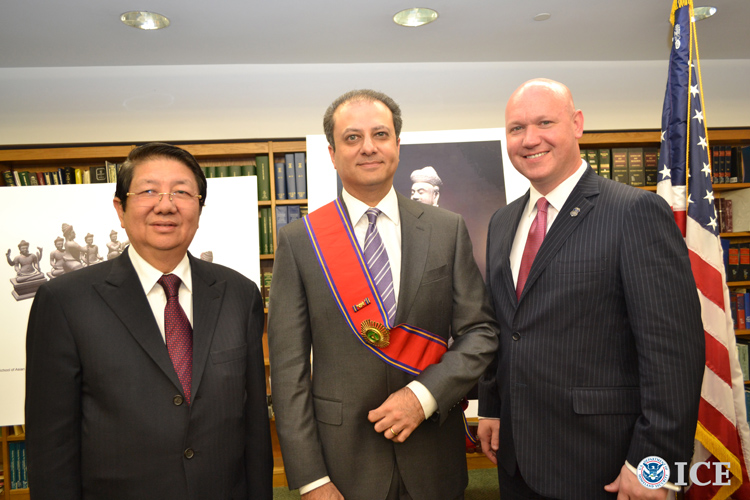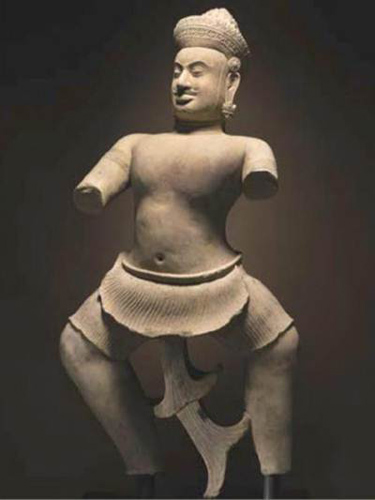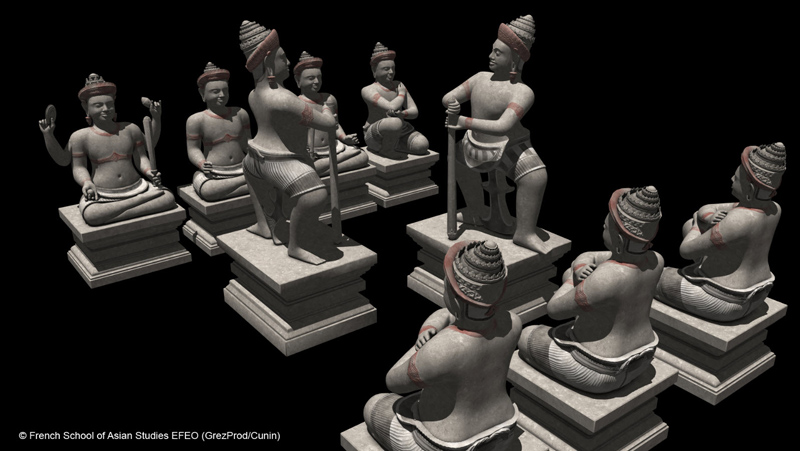Cambodian officials recognize HSI for return of ancient sandstone sculpture
NEW YORK — At a May 7 ceremony in New York, U.S. Immigration and Customs Enforcement's (ICE) Homeland Security Investigations (HSI) and the U.S. Attorney's Office for the Southern District of New York were commemorated by the Kingdom of Cambodia Deputy Prime Minister Dr. Sok An and other representative from the Cambodian government for the return of the Duryodhana, a 10th century sandstone sculpture. Cambodian and U.S. officials were joined at the ceremony was by The United Nations Educational, Scientific and Cultural Organization (UNESCO) and L'École Française d'Extrême-Orient (EFEO).
The return of the Duryodhana follows the settlement of a civil forfeiture action filed by the U.S. Attorney's Office, which alleged that the Duryodhana was stolen from the Prasat Chen temple at Koh Ker in 1972 by an organized looting network, and ultimately imported into the United States and offered for sale by Sotheby's Inc. (Sotheby's). The settlement of the civil forfeiture action, which was approved Dec. 16, 2013 by U.S. District Judge George B. Daniels, required Sotheby's and the customer selling the Duryodhana, Decia Ruspoli de Poggia Suasa (Ruspoli), to return the sculpture to the Kingdom of Cambodia.
"HSI is proud to partner with the Southern District of New York to return this statue to the people of Cambodia after a more than 40-year absence," said HSI Special Agent in Charge James T. Hayes, Jr. "HSI is committed to continuing to be the dominant force in preserving and maintaining the integrity of cultural symbols throughout the world."
"A priceless piece of Cambodia's cultural history was stolen over 40 years ago," said Manhattan U.S. Attorney Preet Bharara. "Once stolen, the Duryodhana should not have been for sale at any price. By bringing legal action to cause the return of the Duryodhana to the Kingdom of Cambodia, we have reaffirmed our commitment to ensuring that Manhattan does not become a Mecca for stolen art and antiquities. Everyone who sells, collects, or curates art should support doing what is right when it comes to repatriating priceless stolen artifacts. We are proud to have played a role in removing the Duryodhana from the stream of commerce, and pleased to commemorate its imminent return to its homeland."
"On behalf of the people and the Royal Government of Cambodia led by Prime Minister Samdech Akka Moha Sena Padei Techo Hun Sen, I would like to express my deepest appreciation to all the parties concerned for their respective contributions to such a great achievement," said Deputy Prime Minister Dr. Sok An, minister in charge of the Office of the Council of Ministers for the Kingdom of Cambodia. "After a long 40-year journey, surviving civil wars, looting and smuggling, the statue had travelled through Thailand, United Kingdom, Belgium and the United States of America. Duryodhana is about to say good-bye now to this beautiful country and their people who helped him regain his freedom and return home."
According to an amended complaint filed in Manhattan federal court April 2013, and other documents filed in the case, from 928 to 944 A.D., Koh Ker was the capital of the ancient Khmer empire in Cambodia. The Khmer regime under Jayavarman IV constructed a vast complex of sacred monuments at Koh Ker, including the Prasat Chen temple and its statuary. These monuments have never been transferred to any private owner, and remain the property of the Cambodian state.
During the civil conflicts of the 1960s and 1970s, statues and other artifacts were stolen from Koh Ker and entered the international art market through an organized looting network. In the case of monumental statues like the Duryodhana, the heads would sometimes be forcibly detached from the torsos and transported first, with the torsos following later, due to the physical challenges of transporting the large torsos on dirt roads. The statues would then be transported to the Cambodia-Thailand border, and transferred to Thai brokers, who would in turn transport them to dealers of Khmer artifacts in Thailand, particularly Bangkok. These dealers would sell the artifacts to local or international customers, who would either retain the pieces or sell them on the international art market.
The Duryodhana, along with a companion statue, the Bhima, was stolen from Prasat Chen in 1972 via this looting network. The heads of the statues were removed and transported first, followed by the torsos, and ultimately delivered to a Thai dealer based in Bangkok. The Duryodhana and the Bhima were then obtained by a well-known collector of Khmer antiquities (Athe Collector@). The Duryodhana was sold to a Belgian businessman in 1975 and was ultimately transferred to his widow, Ruspoli.
In 2010, Ruspoli consigned the Duryodhana to Sotheby's. Sotheby's imported it into the United States and offered it for sale in 2011.
HSI plays a leading role in criminal investigations that involve the illegal importation and distribution of cultural property, including the illicit trafficking of cultural property, especially objects that have been reported lost or stolen. The HSI Office of International Affairs, through its 67 attaché offices in 48 countries, works closely with foreign governments to conduct joint investigations.
HSI specially trained investigators, assigned to both domestic and international offices, partner with governments, agencies and experts to protect cultural antiquities. They also provide cultural property investigative training to law enforcement partners for crimes involving stolen property and art, and how to best enforce the law to recover these items when they emerge in the marketplace.
Since 2007, more than 7,150 artifacts have been returned to 27 countries, including paintings from France, Germany, Poland and Austria, 15th to 18th century manuscripts from Italy and Peru, as well as cultural artifacts from China, Cambodia and Iraq.
Learn more about HSI cultural property, art and antiquities investigations. Members of the public who have information about suspected stolen cultural property are urged to call the toll-free HSI tip line at 1-866-DHS-2-ICE, or to complete its online tip form.




